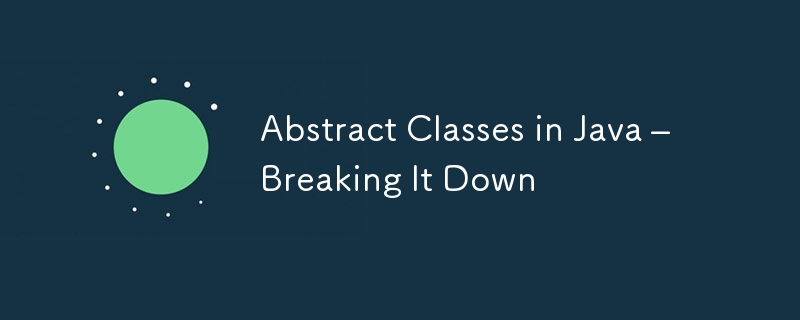Home >Java >javaTutorial >Abstract Classes in Java – Breaking It Down
Abstract Classes in Java – Breaking It Down
- WBOYWBOYWBOYWBOYWBOYWBOYWBOYWBOYWBOYWBOYWBOYWBOYWBOriginal
- 2024-09-04 06:46:32581browse

What is an Abstract Class?
An abstract class is like a blueprint for other classes. You can’t create an object directly from an abstract class. Instead, you use it as a foundation for other classes that can build upon it and fill in the details.
Why Use Abstract Classes?
Abstract classes are useful when you want to define a general concept that has some shared features, but you also want to leave room for specific details that can vary in different situations. For example, you might have a general concept of an "Animal" that includes common features like eating or sleeping, but different animals might eat or sleep in different ways.
Creating an Abstract Class
Here’s how you might create an abstract class called Animal:
public abstract class Animal {
abstract void makeSound(); // Abstract method, no body
void sleep() {
System.out.println("This animal sleeps.");
}
}
In this example, makeSound() is an abstract method, meaning it doesn’t have a body yet. The sleep() method, however, is fully implemented.
Extending an Abstract Class
Now, let’s create some classes that extend the Animal class:
public class Dog extends Animal {
void makeSound() {
System.out.println("The dog barks.");
}
}
public class Cat extends Animal {
void makeSound() {
System.out.println("The cat meows.");
}
}
Both Dog and Cat classes must provide their own version of the makeSound() method, but they inherit the sleep() method as is.
Abstract Class vs. Interface
- Inheritance: A class can extend only one abstract class but can implement multiple interfaces.
- Method Implementation: An abstract class can have both abstract methods (without a body) and fully implemented methods. An interface (before Java 8) can only have abstract methods.
- Constructor: Abstract classes can have constructors, while interfaces cannot.
Partial Implementation
An abstract class is great when you have some methods that should be shared among all child classes, but you also want to force some methods to be defined by those child classes.
public abstract class Bird extends Animal {
void move() {
System.out.println("The bird flies.");
}
}
Now, any class that extends Bird will inherit both the move() method and the sleep() method from Animal, but still needs to implement makeSound().
Challenge: Try It Yourself!
- Create an abstract class called Vehicle with an abstract method startEngine().
- Make two classes, Car and Motorcycle, that extend Vehicle and implement the startEngine() method.
- Add a common method to Vehicle, like stopEngine(), and see how it works in the child classes.
Conclusion
Abstract classes in Java provide a way to create a shared foundation for related classes while leaving room for those classes to define specific details. They strike a balance between shared functionality and flexibility, making your code both powerful and reusable.
The above is the detailed content of Abstract Classes in Java – Breaking It Down. For more information, please follow other related articles on the PHP Chinese website!

